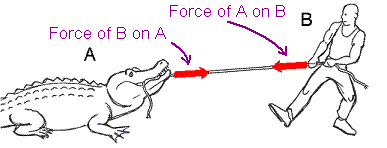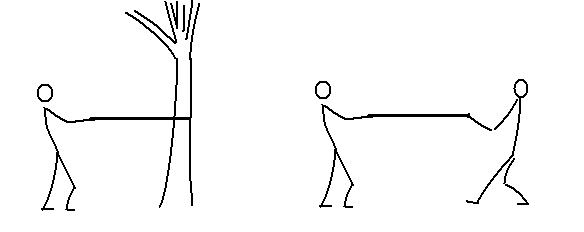Science Content: Force
Weighing something involves a measurement. When we weigh an object, we are
determining the size of the gravitational force -- the attraction due to the earth
itself.
We often measure the weight of an object as a way to determine its mass.
For those of us who stay on Earth, the gravitational force on an object (its
weight) seems to be the same everywhere, with the result that most people do
not clearly distinguish between mass and weight. However, mass is an invariant
property of an object, while the weight of an object varies slightly from
place to place even on the surface of the earth, and more so in the universe
in general (when you visit the Moon, you will find it much easier to climb
stairs because you weigh much less. But your belt will still be too tight,
and your mass has not changed). For this reason we will try to avoid
mentioning the mass unit (gram or Kilogram) now. What other people would
call a 100 gram mass will be characterized as a weight of (very nearly) 1
Newton. As long as we are discussing forces, we will always use Newtons, and
never use grams.
Direction of a force, and the Law of Interaction
Force is a quantity that has both a size and a direction. The gravitational
force is downwards but we can push and pull in other directions, too.
 When we talk about a force, we have
to specify "who" is pulling on "what". For example, in a
friendly tug of war, Mr. B pulls on his pet alligator A, exerting a force called
"the force of B on the alligator." But there is another force present, "the force of the
alligator on B". These two forces are opposite in direction, and exactly equal.
The general statement is one of Newton's laws, The Law of Interaction:
When object A exerts a force on object B, object B exerts an equal and
opposite force on A. This is a statement about interacting systems, and
is true for all kinds of forces without exception. Although in
this example A and B are not moving, the law does not depend
on this; it would still hold if B were throwing an Avocado or
just fanning the Air.
When we talk about a force, we have
to specify "who" is pulling on "what". For example, in a
friendly tug of war, Mr. B pulls on his pet alligator A, exerting a force called
"the force of B on the alligator." But there is another force present, "the force of the
alligator on B". These two forces are opposite in direction, and exactly equal.
The general statement is one of Newton's laws, The Law of Interaction:
When object A exerts a force on object B, object B exerts an equal and
opposite force on A. This is a statement about interacting systems, and
is true for all kinds of forces without exception. Although in
this example A and B are not moving, the law does not depend
on this; it would still hold if B were throwing an Avocado or
just fanning the Air.

In the first picture, Al is testing the strength of a rope, by pulling on it.
In the second picture, Ben is helping.
With two people pulling on the rope, is it more likely to break?
-No, it is exactly the same. In the first picture, the force Al exerts on the tree
(with the aid of the rope) is equal and opposite to the force the tree
exerts on Al. In the second picture, Ben has replaced the tree but as far as the rope
is concerned, nothing has changed.
Outline of the course on Force, Motion, and Energy
Copyright 2005 J. P. Straley and S. A. Shafer
 When we talk about a force, we have
to specify "who" is pulling on "what". For example, in a
friendly tug of war, Mr. B pulls on his pet alligator A, exerting a force called
"the force of B on the alligator." But there is another force present, "the force of the
alligator on B". These two forces are opposite in direction, and exactly equal.
The general statement is one of Newton's laws, The Law of Interaction:
When object A exerts a force on object B, object B exerts an equal and
opposite force on A. This is a statement about interacting systems, and
is true for all kinds of forces without exception. Although in
this example A and B are not moving, the law does not depend
on this; it would still hold if B were throwing an Avocado or
just fanning the Air.
When we talk about a force, we have
to specify "who" is pulling on "what". For example, in a
friendly tug of war, Mr. B pulls on his pet alligator A, exerting a force called
"the force of B on the alligator." But there is another force present, "the force of the
alligator on B". These two forces are opposite in direction, and exactly equal.
The general statement is one of Newton's laws, The Law of Interaction:
When object A exerts a force on object B, object B exerts an equal and
opposite force on A. This is a statement about interacting systems, and
is true for all kinds of forces without exception. Although in
this example A and B are not moving, the law does not depend
on this; it would still hold if B were throwing an Avocado or
just fanning the Air.
